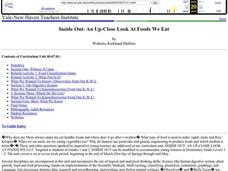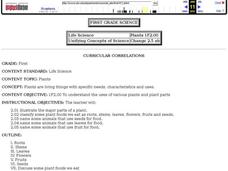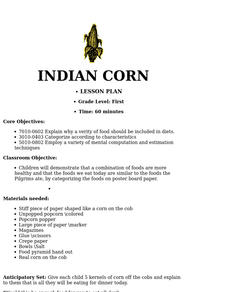Food Teacher Resources
Find Food lesson plans and worksheets
Showing 147 resources
Curated OER
THE FOODS WE EAT
Students discuss the five food groups and the seven basic nutrients. They decorate Food We Eat booklet pages with pictures of foods found on background, rubber stamp and animation tools in KidPix. (Booklet has a page for each food group.)
Curated OER
Giving Thanks for Food and Farms
Sarah Stewart’s The Gardener and Food from Farms by Nancy Dickmann display the importance of community farms. After reading these short picture books, class members draw connections between farms and the food we eat each day. As a...
Curated OER
Earth: The Food We Eat, The Seeds We Sow
Students explore the importance of seed diversity for cultural and ecological stability/health. They discover what an heirloom seed is and why they are important to conserve.
Curated OER
The Foods we Eat (Los Alimentos)
Sixth graders sing a song and create flashcards showing their favorite foods. In this Spanish "What do you like? lesson, 6th graders display Spanish foods using a document camera and graph their favorites.
TED-Ed
How The Food You Eat Affects Your Gut
Some foods we eat are not meant to be broken down by our digestive systems, but instead by our gut. But how can we control what our gut breaks down? The answer is simple: our diet.
Baylor College
Bio Build-up
Trace pollutants through the environment in the seventh lesson plan of this series on the science of food. Looking at a picture of the plants and animals in an aquatic ecosystem, learners use dot stickers to represent harmful chemicals...
TED-Ed
Why Do We Pass Gas?
Flatulence is a fact of life. But what exactly is happening in our bodies that produces this excess gas? Find out with this entertaining, yet educational, video that explores the different types of bacteria that aid digestion and the...
MinuteEarth
Why Is Poop Brown And Pee Yellow?
We all do it ... why not have a better understanding of the process? Life science scholars discover how the colorful foods we eat are either brown or yellow when our bodies have finished with them. The narrator leads the tour through the...
K20 LEARN
Speedy Cat: Enzymes
Enzymes have a need for speed! What happens when they are forced to slow down? A well-rounded lesson plan from the K20 Center examines enzyme activity through role playing and a lab. Biology scholars work in teams and pairs to understand...
Curated OER
The Foods We Eat: Towards a Balanced Diet
Students list at least 10 different food items grown/produced in their community, identify what each food item contains and make a list of different food items which constitute a balanced diet. They bring in food samples and write food...
Curated OER
Thank You For the Food We Eat
Students explore where our food comes from. In this science lesson plan, students discuss how much of our food comes from animals. Students construct a mobile.
Curated OER
Activity Plan 3-4: Scrumptious Shapes
Young scholars discover together that shapes are everywhere - even in the food we eat. In this early childhood math and art lesson, students read about shapes, identify foods that match geometric shapes, and create a class book.
Curated OER
Where Does Food Come From?
Students recognize that food we eat comes from farms. In this where does food come from lesson plan, students discuss planting crops and how they grow. Students plant seeds for edible crops and eat them when are ripe. Students sing a...
Curated OER
Digestive System
Students analyze how the digestive system works by taking the food we eat and breaking it down for our bodies to use for various reasons. They list the major components of the digestive system and draw a diagram. They explain how...
Curated OER
Inside Out: An Up-Close Look At Foods We Eat
Fourth graders identify the origins of meats and vegetables consumed by humans on a daily basis. They classify foods (meats, dairy products, grains...) and create a food pyramid.
Curated OER
Gifts from the Sea
Students discover the oceanic food chain. In this healthy eating instructional activity, student investigate the fish we eat and the food the fish eat. Students discover what ocean animals eat seaweed and what everyday foods we eat...
Curated OER
On The Farm
Students study a dairy farm and also the crops that grow on farms. They research how we depend on farms to get the food we eat. They transform their findings and describe one the farms or make up their own. They turn the information...
Curated OER
The Food We Eat
Students plan a menu for one day after they study the food pyramid and learn about their daily food requirements. They are given an updated food pyramid with a summary fo dietary recommendations that replaces the old standard "four food...
Curated OER
Plants
Students illustrate the major parts of a plant, classify some plant foods we eat as roots, stems, leaves, flowers, fruits and seeds. They also name some animals that use seeds, leaves, and fruit for food.
Curated OER
Oh That Gross Digestive System!
Young scholars get an understanding of the main components of the digestive system and how the system takes the food we eat and converts it into energy.
Curated OER
Digestion and Nutrition
In this homeostasis learning exercise, students will read about how the food we eat helps our body to maintain homeostasis. Students will complete 1 short answer question and 3 true or false questions.
Curated OER
Feed Your Cells
Students examine and research the human digestive system and what happens to the food we eat. They read the article, The Passage of Food, participate in an experiment with crackers, and write a paragraph summarizing the function of the...
Virginia Department of Education
Acid-Base Theory
Litmus paper, why so blue? A chemistry lesson includes a pre-lab activity, practice calculating pH, an experiment measuring the pH in acids and bases, a titration demonstration, and a titration experiment.
Curated OER
Indian Corn
First graders demonstrate that eating combinations of food is very healthy. They discover that foods we eat today are similar to the foods the Pilgrims ate by categorizing the foods on poster board paper.

























